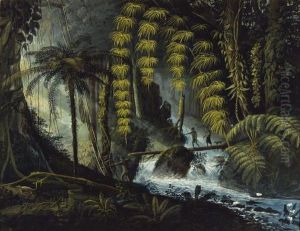Charles Othon Frederic Jean Baptiste Paintings
Charles Othon Frédéric Jean-Baptiste de Clarac, known as the Comte de Clarac, was a French artist, scholar, archaeologist, and curator. Born on December 27, 1774, in Paris, France, he was a figure of some importance in the early 19th-century study of ancient art and archaeology. His aristocratic background allowed him to pursue his interests in the arts and antiquities, which were profoundly influenced by the neoclassical tastes of his time.
Clarac's life spanned an era of significant upheaval and change, including the French Revolution and the Napoleonic Wars. Despite the tumultuous times, he managed to travel extensively, which furthered his interest in ancient civilizations, particularly those of Greece and Rome. His travels and studies in Italy, and particularly his time spent in Rome, were crucial to his development as a scholar and connoisseur of ancient art.
In 1805, Clarac began his curatorial career at the Musée Napoléon (later renamed the Louvre Museum) in Paris, where he was appointed as a curator of antiquities. He was responsible for cataloging and expanding the museum's collection of classical sculpture. One of his significant contributions was his work on the 'Musée de sculpture antique et moderne', a comprehensive catalog that not only listed the works but also offered detailed descriptions, historical context, and engravings of the pieces. This work, which was published in several volumes from 1826 to 1852, was instrumental in the study of classical sculpture and contributed to the development of art history as an academic discipline.
Clarac's work at the Louvre was characterized by a systematic approach to the study of antiquities, and he was among the first to apply a more scientific methodology to the analysis and classification of ancient artworks. His contributions to the museum and the field of art history were significant, and he played a role in shaping the Louvre's reputation as a premier institution for the study of ancient art.
De Clarac was also an artist in his own right, though he is not as well-known for his artistic output as for his scholarly works. His artworks were primarily drawings and engravings that reflected his interest in ancient art and architecture.
He died on February 17, 1837, in Paris, having left behind a legacy of scholarly work that would influence the fields of archaeology and art history for generations. His meticulous approach to cataloging and his passion for the classical past set a standard for future scholars and helped to establish the academic discipline of art history.
